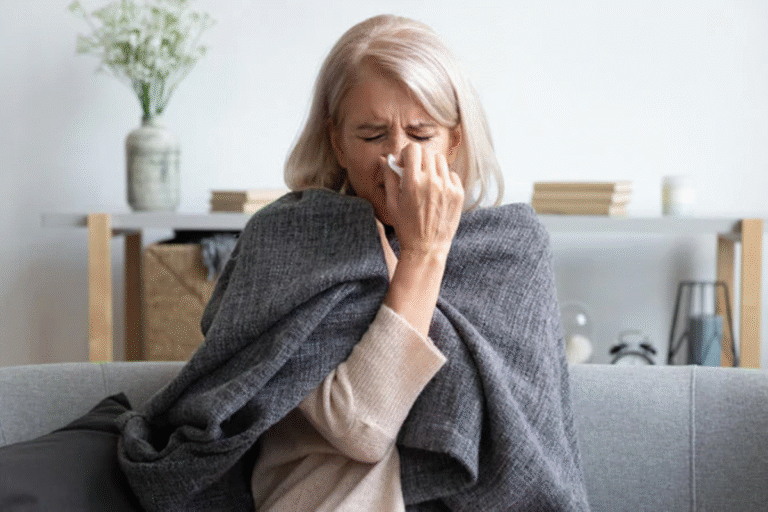
Angela, 53, thought her perimenopause journey was winding down. Her periods had become irregular over the last year—sometimes skipping a few months entirely—so when she suddenly started bleeding again, she assumed it was just her hormones doing something weird. But then the bleeding got heavier… and it didn’t stop. She brushed it off for a few weeks, thinking it was just part of “the change,” but something about this felt different. After a visit with her OB/GYN and a biopsy, she received a diagnosis that rocked her: uterine cancer.
What Is Uterine Cancer?
Uterine cancer, also called endometrial cancer, is the most common gynecologic cancer in the U.S. It occurs when abnormal cells form in the lining of the uterus (the endometrium). Most cases are diagnosed after menopause, but many start developing during the perimenopausal years when hormones begin to shift.
The good news? When detected early, uterine cancer is highly treatable. The challenge is recognizing when irregular bleeding isn’t just “perimenopause,” but something more serious.
Why It’s Often Missed in Midlife
During perimenopause, it’s common for cycles to become erratic. But this hormonal transition can mask red flags, causing many women to delay evaluation.
Here’s why:
- Irregular bleeding, a hallmark symptom of uterine cancer, is also common during perimenopause
- Women may normalize heavy or prolonged periods
- Many are told, “It’s just hormones”—without further investigation
And because there’s no routine screening test like a Pap smear for uterine cancer, awareness of symptoms and risk factors is crucial for early detection.
Signs and Symptoms of Uterine Cancer
The most common symptom of uterine cancer is abnormal vaginal bleeding, especially:
- Bleeding after menopause
- Spotting between periods
- Prolonged or heavy periods, particularly if different from your norm
- Bleeding after sex
- Pelvic pain or pressure
- Watery or blood-tinged vaginal discharge
If you’re postmenopausal, any bleeding is abnormal and should be evaluated. In women over 35, irregular or very heavy bleeding—especially with risk factors—warrants attention.
Risk Factors for Uterine Cancer
While any woman can develop uterine cancer, the following risk factors increase the likelihood:
- Obesity (excess body fat increases estrogen production)
- PCOS (due to prolonged estrogen exposure and low progesterone)
- Unopposed estrogen (estrogen without progesterone, either naturally or through HRT)
- Late menopause (after age 55)
- Early menarche (before age 12)
- Never having been pregnant
- Diabetes or insulin resistance
- Family history of uterine, colon, or ovarian cancer
- Lynch syndrome (HNPCC)
- Tamoxifen use (a breast cancer medication that can stimulate the endometrial lining)
Estrogen dominance—where estrogen levels are high relative to low progesterone—is a common thread. This is especially common in perimenopause, when ovulation (and therefore progesterone production) becomes irregular.
Screening and Diagnosis
Unlike cervical cancer, there is no standard screening test for uterine cancer in average-risk women. However, your provider may recommend testing if you experience concerning symptoms or have risk factors.
Typical evaluation includes:
- Pelvic exam to check for uterine enlargement or tenderness
- Transvaginal ultrasound to measure the thickness of the endometrium
- Endometrial biopsy (the gold standard for diagnosis)
- Hysteroscopy or D&C if the biopsy is inconclusive or symptoms persist
At Antigravity Wellness, we collaborate with your OB/GYN and advocate for appropriate imaging and testing when symptoms suggest more than hormonal changes. We take your concerns seriously.
Red Flags That Warrant Immediate Evaluation
Contact your provider ASAP if you experience:
- Postmenopausal bleeding, even light spotting
👉 Caveat: If you’ve recently started estrogen therapy, some light spotting or bleeding can be normal during the adjustment phase—especially if you still have a uterus and are taking combined estrogen and progesterone therapy.
However, persistent, heavy, or recurrent bleeding should always be evaluated to rule out uterine lining overgrowth or malignancy.
👉 See our full blog post on Postmenopausal Spotting After Starting Estrogen Therapy: What You Need to Know for what’s normal, what’s not, and when to follow up. - Heavy or prolonged periods that are worsening
- Bleeding between cycles, especially after age 40
- Pelvic pain, fullness, or bloating that doesn’t resolve
- Unusual discharge
- A personal or family history of reproductive cancers or Lynch syndrome
Holistic Support at Antigravity Wellness
Whether you’re monitoring symptoms, navigating a diagnosis, or recovering from treatment, our holistic approach helps support your body at every stage.
✅ Nutrition for Hormone and Immune Support
- Cruciferous vegetables (broccoli, cauliflower, Brussels sprouts) to support estrogen metabolism
- Fiber-rich foods to help eliminate excess hormones
- Anti-inflammatory staples: turmeric, leafy greens, berries, flaxseed
- Limit alcohol, processed sugar, and high-glycemic foods
✅ Movement
- Gentle resistance training and walking improve insulin sensitivity and immune health
- Support lymphatic flow and detoxification
✅ Mind-Body Support
- Practice nervous system regulation with breathwork, grounding, and body-based therapies
- Journaling, therapy, or support groups for emotional processing
✅ Supplements (with guidance)
- DIM, calcium-D-glucarate, magnesium, and methylated B vitamins to support detox pathways
- Curcumin or resveratrol for inflammation and cell health
Explore trusted options in our Fullscript Supplement Shop—but always consult your provider first, especially if you are undergoing treatment.
Advanced Testing for Prevention and Personalized Care
At Antigravity Wellness, we offer functional testing to identify hormonal imbalances and metabolic risks long before they escalate into disease.
We may recommend:
- DUTCH test to assess estrogen, progesterone, and detox pathways
- GI MAP to check for gut dysbiosis and inflammation
- Comprehensive metabolic panels
- Fasting insulin and A1c for blood sugar control
- hs-CRP and homocysteine for inflammation and cardiovascular risk
Understanding these markers helps us create a proactive strategy for prevention and healing.
Case Study: Meet Elaine
Elaine, 49, came to Antigravity Wellness for worsening PMS, bloating, and heavy bleeding that lasted 10+ days. She assumed it was just perimenopause—but because her symptoms had changed rapidly, we referred her to her OB/GYN for further evaluation.
A transvaginal ultrasound revealed a thickened endometrial lining, and a biopsy confirmed early-stage endometrial cancer. Because it was caught early, she underwent a successful hysterectomy and is now cancer-free.
Elaine returned to us to support her recovery through:
- Hormone detoxification
- Gut healing
- Strength training and metabolic support
- Nervous system regulation after the emotional toll of diagnosis
Today, Elaine is thriving—and passionate about encouraging other women not to ignore their symptoms.
Uterine Cancer Is Common—But It Doesn’t Have to Be Deadly
Too often, women ignore irregular bleeding or painful periods because they’re told it’s “normal for your age.” But you are the expert on your body, and persistent symptoms deserve investigation—not dismissal.
The earlier uterine cancer is found, the better the outcome. And even better than early detection? Prevention through hormone balance, inflammation reduction, and metabolic support.
If something feels off with your cycle or bleeding pattern, don’t wait. Let’s get clarity—together.
👉 Book your Brief Initial Consult now
👉 Explore our top hormone detox and inflammation support supplements in the Fullscript Shop
Resources and References
- American Cancer Society. “Uterine Cancer: Key Statistics.” 2023. https://www.cancer.org/cancer/types/uterine-sarcoma.html
- Felix AS, et al. “High prevalence of endometrial cancer precursors in women with Lynch syndrome.” Gynecol Oncol. 2011;121(2):324–328. https://doi.org/10.1016/j.ygyno.2011.01.034
- Kaaks R, et al. “Obesity, endogenous hormones, and endometrial cancer risk: a synthetic review.” Cancer Epidemiol Biomarkers Prev. 2002;11(12):1531–1543. https://cebp.aacrjournals.org/content/11/12/1531
- Clarke MA, et al. “Association of Endometrial Cancer Risk With Postmenopausal Bleeding in Women.” JAMA Intern Med. 2018;178(9):1210–1212. https://doi.org/10.1001/jamainternmed.2018.2820




